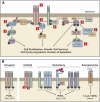Complexity in the signaling network: insights from the use of targeted inhibitors in cancer therapy
- PMID: 22474259
- PMCID: PMC3323875
- DOI: 10.1101/gad.186965.112
Complexity in the signaling network: insights from the use of targeted inhibitors in cancer therapy
Abstract
Cancer often arises when normal cellular growth goes awry due to defects in critical signal transduction pathways. A growing number of inhibitors that target specific components of these pathways are in clinical use, but the success of these agents has been limited by the resistance to inhibitor therapy that ultimately develops. Studies have now shown that cancer cells respond to chronic drug treatment by adapting their signaling circuitry, taking advantage of pathway redundancy and routes of feedback and cross-talk to maintain their function. This review focuses on the compensatory signaling mechanisms highlighted by the use of targeted inhibitors in cancer therapy.
Figures




Similar articles
-
Durability of Kinase-Directed Therapies--A Network Perspective on Response and Resistance.Mol Cancer Ther. 2015 Sep;14(9):1975-84. doi: 10.1158/1535-7163.MCT-15-0088. Epub 2015 Aug 11. Mol Cancer Ther. 2015. PMID: 26264276 Review.
-
Inside the biochemical pathways of thymidylate synthase perturbed by anticancer drugs: Novel strategies to overcome cancer chemoresistance.Drug Resist Updat. 2015 Nov;23:20-54. doi: 10.1016/j.drup.2015.10.003. Epub 2015 Oct 31. Drug Resist Updat. 2015. PMID: 26690339 Review.
-
From traditional molecular biology to network oncology.Future Oncol. 2011 Feb;7(2):155-9. doi: 10.2217/fon.10.190. Future Oncol. 2011. PMID: 21345133 No abstract available.
-
Molecular Pathways: Clinical Applications and Future Direction of Insulin-like Growth Factor-1 Receptor Pathway Blockade.Clin Cancer Res. 2015 Oct 1;21(19):4270-7. doi: 10.1158/1078-0432.CCR-14-2518. Clin Cancer Res. 2015. PMID: 26429980 Free PMC article. Review.
-
Compensatory pathways in oncogenic kinase signaling and resistance to targeted therapies: six degrees of separation.Cancer Discov. 2012 Oct;2(10):876-80. doi: 10.1158/2159-8290.CD-12-0400. Cancer Discov. 2012. PMID: 23071031
Cited by
-
Network features suggest new hepatocellular carcinoma treatment strategies.BMC Syst Biol. 2014 Jul 29;8:88. doi: 10.1186/s12918-014-0088-0. BMC Syst Biol. 2014. PMID: 25070212 Free PMC article.
-
Active fraction (HS7) from Taiwanofungus camphoratus inhibits AKT-mTOR, ERK and STAT3 pathways and induces CDK inhibitors in CL1-0 human lung cancer cells.Chin Med. 2017 Nov 15;12:33. doi: 10.1186/s13020-017-0154-9. eCollection 2017. Chin Med. 2017. PMID: 29177004 Free PMC article.
-
Combined SFK/mTOR inhibition prevents rapamycin-induced feedback activation of AKT and elicits efficient tumor regression.Cancer Res. 2014 Sep 1;74(17):4762-71. doi: 10.1158/0008-5472.CAN-13-3627. Epub 2014 Jul 14. Cancer Res. 2014. PMID: 25023728 Free PMC article.
-
Ten things you should know about protein kinases: IUPHAR Review 14.Br J Pharmacol. 2015 Jun;172(11):2675-700. doi: 10.1111/bph.13096. Epub 2015 Mar 24. Br J Pharmacol. 2015. PMID: 25630872 Free PMC article. Review.
-
Using Pharmacokinetic Profiles and Digital Quantification of Stained Tissue Microarrays as a Medium-Throughput, Quantitative Method for Measuring the Kinetics of Early Signaling Changes Following Integrin-Linked Kinase Inhibition in an In Vivo Model of Cancer.J Histochem Cytochem. 2015 Sep;63(9):691-709. doi: 10.1369/0022155415587978. Epub 2015 May 4. J Histochem Cytochem. 2015. PMID: 25940338 Free PMC article.
References
-
- Cantley LC 2002. The phosphoinositide 3-kinase pathway. Science 296: 1655–1657 - PubMed
Publication types
MeSH terms
Substances
LinkOut - more resources
Full Text Sources
Other Literature Sources
Medical
